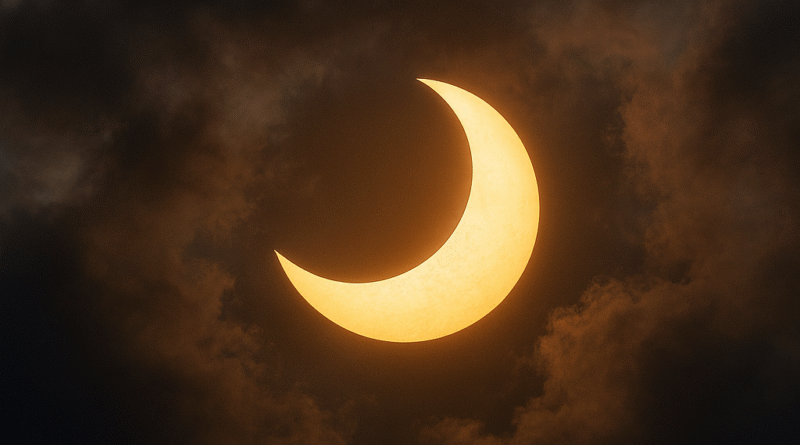September 21 2025 Solar Eclipse: Visibility, Timings & Safety Tips
The September 21 2025 solar eclipse will be a rare partial solar eclipse visible from New Zealand, eastern Australia, parts of the Pacific, and Antarctica. This astronomical event will darken the Sun by up to 85%, creating a dramatic crescent shape in the sky for millions of skywatchers.
Eclipse Path & Visibility (Who Can See It?)
NASA and other sources agree that this eclipse is confined to the Southern Hemisphere, especially the South Pacific region. North or South America, Europe, Africa and most of Asia will not see this eclipse. For example, TimeandDate notes it will be visible “from New Zealand, plus a thin strip of Australia’s eastern coast, various Pacific islands, and parts of Antarctica”. Similarly, Wikipedia reports visibility across much of Oceania and Antarctica, with up to ~80% of the Sun obscured at southern New Zealand’s locations. In the Northern Hemisphere virtually nobody will notice it – Livescience quips that “the new moon will rise without anyone in the Northern Hemisphere noticing” while millions of penguins in Antarctica will witness the eclipse.
The global timeline is brief. The eclipse begins around 17:29 UTC, reaches greatest coverage at about 19:41 UTC, and ends by 21:53 UTC. These are UTC times; locally this means the eclipse will occur at sunrise on Sept. 22 for New Zealand and Antarctica, and on Sept. 21 in Australia and Pacific islands.) The table below summarizes visibility by major region:
| Region | Visible? | Peak Coverage (%) | Timing (local date/time) | Notes |
|---|---|---|---|---|
| North America | No | – | – | Eclipse occurs during night; not visible. |
| South America | No | – | – | No land area of S. America is in the path. |
| Europe | No | – | – | Eclipse shadow misses Europe entirely. |
| Africa | No | – | – | Not visible from any part of Africa. |
| Asia | No | – | – | Except remote Pacific atolls (Oceania), no impact. |
| Oceania (Australia & NZ) | Yes | ~72–85% | Sept 21–22, early AM | Eastern Australia sees a small partial (~Sept 21 AM local); New Zealand sees ~72–85% at sunrise Sept 22. |
| Antarctica | Yes | ~85–86% | Sept 22, early AM | Visible from research stations (e.g. McMurdo) near local sunrise. |
In Oceania, only a narrow region sees the eclipse. Eastern Australia (e.g. Sydney, Canberra) will catch a small partial near sunrise on Sept. 21 . New Zealand is much better placed: for instance, Dunedin will see the Sun rise already eclipsed (about 72% covered) and reach ~72% coverage about 40 minutes later. The peak coverage occurs over the Southern Ocean and Antarctic Ross Sea – EarthSky notes about 85% of the Sun will be hidden at maximum (roughly 19:41 UTC). TimeandDate’s data show that roughly 16.6 million people live under even a partial eclipse, mainly in New Zealand, Australia and scattered Pacific islands.
How to Watch the Partial Solar Eclipse 2025 Safely
Never look at the Sun without proper protection – even a partially eclipsed Sun can cause serious eye damage. Always use ISO-certified solar eclipse glasses or viewers. Regular sunglasses (no matter how dark) do not block enough light. NASA advises that observers “must look through safe solar viewing glasses (‘eclipse glasses’) or a safe handheld solar viewer at all times” during partial phases. Inspect any eclipse glasses before use, and discard them if torn or scratched.
If you lack eclipse glasses, use indirect viewing methods. For example, make a simple pinhole projector (a small hole in a card projecting the Sun’s image on the ground). You can also safely watch live online streams of the event. For photography, never point a camera, binoculars or telescope at the Sun without a proper solar filter – eclipse glasses are not safe to use with optical instruments. Instead, attach a certified solar filter to the front of the camera lens or telescope. (If your camera or binoculars has a built-in “eye-safety” filter, remove it and use a true solar filter.) Always follow eclipse safety guidelines – NASA’s eclipse safety page warns that even tiny unscreened exposures can “instantly cause severe eye injury”.
-
Use certified eclipse glasses or viewers whenever you look at the Sun.
-
Do not use regular sunglasses, camera viewfinders, or binoculars without filters. Attach a solar filter to any camera or telescope lens.
-
Try indirect viewing. A pinhole projector or tree-shadow effect can safely show the eclipse.
-
Supervise children and never let anyone look directly at the Sun without protection.
The September 21 2025 solar eclipse will be a rare partial solar eclipse visible from New Zealand, Australia, the Pacific, and Antarctica. In addition to this eclipse, skywatchers can also look forward to other events like the 2025 Blood Moon – see full details here

